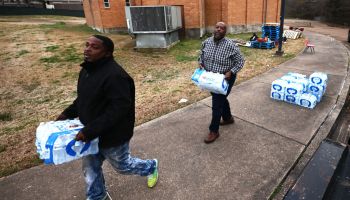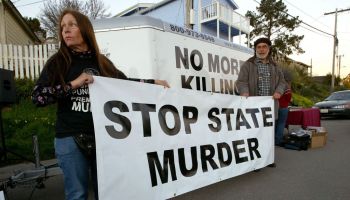COVINGTON, La. — BP on Wednesday launched its latest bid to plug the gushing well in the Gulf of Mexico by force-feeding it heavy drilling mud, a maneuver known as a “top kill” that has never before been tried 5,000 feet underwater.
The oil giant’s chief executive earlier gave the procedure a 60 to 70 percent chance of working, and President Barack Obama cautioned Wednesday there were “no guarantees.”
BP spokesman Steve Rinehart said the company will pump mud for hours, and officials have indicated it may be a couple of days before they know whether the procedure is working. The top kill involves pumping enough mud into the gusher to overcome the flow of oil, and engineers plan to follow it up with cement to try to permanently seal the well.
Text continues after gallery …
A live video stream showed pictures of the oil gushing and the blowout preventer, the five-story device the mud was being pumped into. A weak spot in the device could blow under the pressure, causing a brand new leak.
Gene Beck, a petroleum engineering professor at Texas A&M in College Station, said the endeavor would likely fail quickly if the mud could not overcome the pressure of the oil.
“The longer it goes, maybe the better news that is,” Beck said. “They are hoping that nothing breaks, that they don’t have any failures in what they’re pumping into.”
BP PLC was leasing the rig Deepwater Horizon when it exploded April 20, killing 11 workers and triggering the spill that has so far spewed at least 7 million gallons into the Gulf. Oil has begun coating birds and washing into Louisiana’s delicate wetlands.
Witness statements obtained by The Associated Press show senior managers complained BP was “taking shortcuts” the day of the explosion by replacing heavy drilling fluid with saltwater in the well that blew out.
Truitt Crawford, a roustabout for drilling rig owner Transocean Ltd., told Coast Guard investigators about the complaints. The seawater, which would have provided less weight to contain surging pressure from the ocean depths, was being used to prepare for dropping a final blob of cement into the well.
“I overheard upper management talking saying that BP was taking shortcuts by displacing the well with saltwater instead of mud without sealing the well with cement plugs, this is why it blew out,” Crawford said in his statement. BP declined to comment.
The statements show workers talked just minutes before the blowout about pressure problems in the well. At first, nobody seemed too worried: The chief mate for Transocean left two crew members to deal with the issue on their own.
What began as a routine pressure problem, however, suddenly turned to panic. The workers called bosses to report a situation, with assistant driller Stephen Curtis telling one senior operator that the well was “coming in.” Someone told well site leader Donald Vidrine that they were “getting mud back.” The drilling supervisor, Jason Anderson, tried to shut down the well.
It didn’t work. Both Curtis and Anderson died in the explosion.
At a hearing in New Orleans on Wednesday, Douglas Brown, the Deepwater Horizon’s chief mechanic, testified about what he described as a “skirmish” between someone he called the “company man” — a BP official — and three other employees during a meeting the day of the explosion.
Brown said he didn’t pay particular attention to what they were discussing because it did not involve his engine room duties. He later said he did not know the BP official’s name.
“The driller outlined what would be taking place, but the company man stood up and said ‘We’ll be having some changes to that,'” Brown testified. He said the three other workers initially disagreed but “the company man said ‘This is how it’s going to be.'”
Frustration with BP and the federal government has only grown since then as efforts to stop the leak have failed.
Obama prepared to head to the Gulf on Friday to review efforts to halt the oil that scientists said seems to be growing significantly darker, from what they can see in an underwater video. It suggests that heavier, more-polluting oil is spewing out.
Bob Bea, an engineering professor at the University of California at Berkeley, said the procedure carries a high risk of failure because of the velocity at which the oil may be spewing.
“I certainly pray that it works, because if it doesn’t there’s this long waiting time” before BP can dig relief wells that would cut off the flow, Bea said.
RELATED STORIES
BP “Top Kill” Plan Could Make Oil Spill Worse
As Oil Spill Continues, Obama Touts Alternative Energy Sources
















